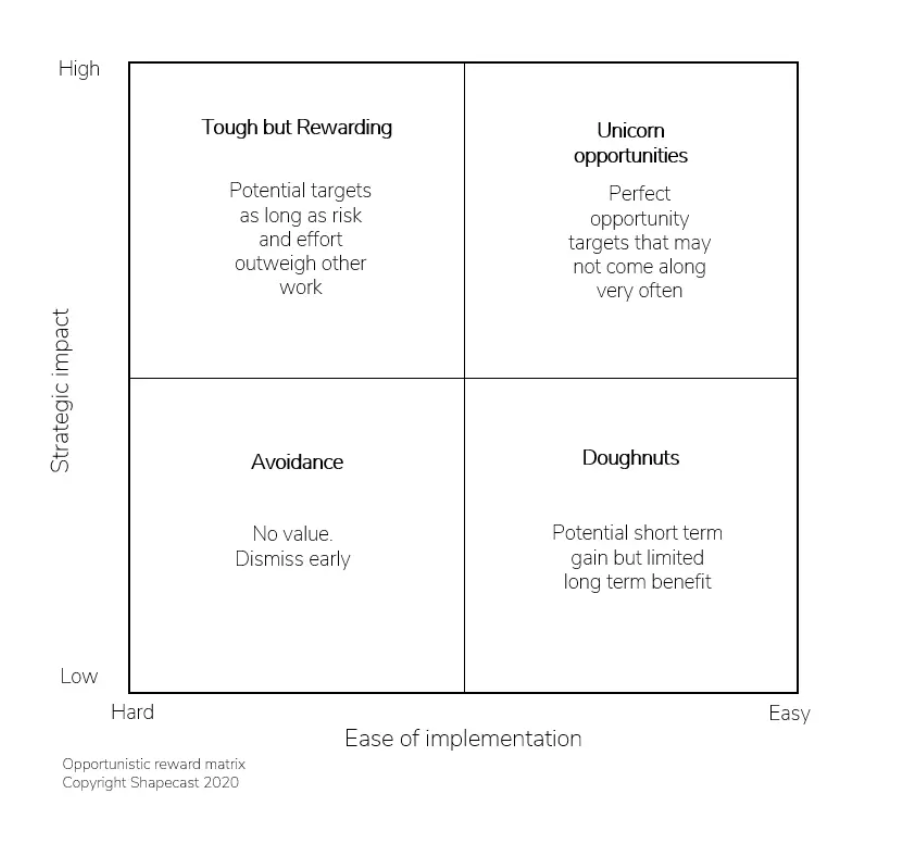As businesses face the forces of geopolitical instability, economic uncertainty and yet more disruption from rapid technological advances we live in a world of unprecedented change, yet with uncertainty there is also opportunity, especially for the brave and agile.
This article outlines some methodical steps we can take to analyse, rank and coordinate a structured approach to the pursuit of strategic opportunities alongside an existing portfolio of work.
A strategic opportunity management methodology
The methodology outlined in this article is designed to help you analyse opportunities and then to grade them for the best fit and lowest level of risk. You’ll then learn how to systematically develop the business capabilities you’ll need to be successful and how to create an agile plan to maintain flexibility in order to adapt to all eventualities.
The methodology breaks down into the following stages, each of which is discussed in more detail:
- Identify & grade new opportunities
- Analyse strategic options
- Analyse capability gaps
- Analyse the impact on the current portfolio
- Implement an agile opportunity execution plan
- Execute & monitor progress
- Align stakeholders
Step 1 – Identify & grade new opportunities.
The first step is to identify new opportunities. While not designed specifically for the purpose of opportunity planning, traditional Ansoff matrix analysis can be used to identify products and services in both existing and new markets that may now be available and easier to service than previously possible.
When looking at these new markets, some of the following questions might help to develop a portfolio of short and longer-term strategic opportunities:
- What are the impacts of change in your markets or your customer’s markets?
- Where are the opportunities to transform faster than would otherwise be possible?
- What are the opportunities for cost reduction of existing fixed assets (such as office space) no longer not required?
- Where can you now improve service levels or offer new services not possible before?
- What are the opportunities to add value to customers where there is a new demand not currently being serviced very well?
- What assumptions are you making about existing customers and how their needs have changed following changes in the current situation?
For example, are your existing customers in need of new ways of delivering existing services or products that your competitors are not able to provide that could win new loyalty and support?
Are there potentially new services which are quite similar to existing products and services which you can quite easily transition to gain market traction quickly?
What about entirely new services in markets you have never considered before which are now easier to service than before due to the change in circumstances? Are there customers and customer groups that you have never considered that are now available to you?
Once a set of opportunities have been identified, rank opportunities based on potential benefit and cost/complexity to implement.
The following classification matrix can be a useful way to grade the opportunities and then prioritise which you are able to support.
Step 2 – Analyse strategic options
Once classified, it is unlikely too many unicorns will be uncovered (unless you’re in a very fortunate industry). For most of us, any opportunity that is both easy chase which also returns huge rewards, is likely to be heavily contested under normal circumstances.
However, these are not normal circumstances and when they arise under stressed conditions such as now, any normally vigilant competitors may be so focused on dealing with their response or internal problems, that with sufficient strategic focus you can go after the opportunity with enough speed and agility to capture a new market.
Once opportunities have been graded and assessed, the next focus area is what options do you have to go after opportunities?
This is the time to potentially think out of the box and ignore old ways of servicing customers.
To help thinking differently, we advocate looking at each opportunity and considering the different dimensions of the opportunity that would mean you can think of new ways of pursuing the opportunity. By dimensions, we mean considering and grading the main attributes that need to be considered.
For example, if the opportunity to offer a new product or service to a market is possible, consider locations you want to offer it in, think of the channels you could offer it through, consider different commercial models. If you’re offering an existing service in a wholly new location and previously you have required fixed assets such as premises, can you use third party premises in a location, or perhaps move to a new business model such as a franchise?
If agility and speed of execution are critical, consider each step required and how you could achieve it faster than previously possible. This may raise assumptions that have not been ever challenged before:
- Do you need your own premises?
- Do you need staff to deliver the product/service?
- Could it be provided online only and deliver the same or equivalent service?
- Could it be automated?
- Could you give it away for free/freemium to get traction?
- Who else could you partner with or create a joint venture with to go after a big or lucrative market quickly together?
Perhaps even old competitors could be considered partners in new markets.
Step 3 – Analyse capability gaps
At this point, you should be in a position where you have new opportunities defined, you will have worked out which opportunities are likely to yield the biggest benefits and new or highly effective ways of servicing the opportunities when you win them.
The next step in the method is to look internally at your organisation and consider which internal or external business capabilities do we need in order to either go after the opportunity or service the opportunity when won.
The last thing you want is a half-baked attempt at going after a new opportunity which will never succeed because you do not have the right capabilities, either internal or externally facing.
If you are not familiar with it, business capability design is a technique which is used within Enterprise Architecture and operating model design to identify business and systems capabilities that must exist for an organisation to be effective.
For example, most organisations need amongst many others, an HR capability, a Finance capability, etc. Each high-level capability subdivides into more specific capabilities such as financial planning, financial operations, etc. Proper analysis for most mid and large organisations will yield an entire hierarchy of business capabilities required.
Having considered the capabilities needed, the next question to address is what level of maturity are required for each capability. If you are going after an enterprise client in a new market, having just the most basic level of account management or delivery capability is not going to cut it.
If a more sophisticated level of capability is required than you currently possess, what options are there to acquire or improve your capability level?
The following questions will be relevant at this stage
- Could you partner or create a joint venture with a supplier or third party quickly to get the capability in house?
- Could you hire new staff quickly enough or perhaps purchase an organisation or system in order to ramp up your capability?
- Could you grow or second capability from another part of the organisation?
Planning the capabilities needed and their maturity is vital to generate the confidence that the opportunity can be both met and serviced.
Creating capability within the business requires its own implementation and execution plan and is a fundamental aspect of strategy execution planning. (More on this in forthcoming blogs).
Step 4 – Analyse the impact on the current portfolio
Analysing the impact of the new opportunity on your current portfolio is critical to help manage the opportunity risk. It might be very tempting to put your best and brightest talent on a new exciting opportunity, but if it means existing service levels drop, the risk is you find that your current business is put at risk in favour of a new opportunity which may never materialise.
How can you ensure you maintain sufficient focus and impetus with current services while providing enough resource and capability for a new opportunity? Perhaps extending investment and hiring in new talent or partners is a better option if it means reducing the risk on the current portfolio.
Consider how long the execution plans will take and whether you can afford long term secondment.
If this opportunity is so great and so real, it might make commercial sense to stop some existing work in favour of your new opportunity.
Step 5 – Implement an agile opportunity execution plan
Use an agile-planning method or ideally strategy execution platform to model your implementation plans for each opportunity, the strategic contribution you expect and the impact of your plans on the wider portfolio.
We would advocate first setting out the objectives and performance measures (either KPIs or OKRs) that you expect as a result of both existing plans and new plans.
Develop plans for both current and new work to enable all the teams involved understand the strategic objectives, their role in the big picture and the importance of both major streams of work.
More importantly, by being objective and outcome focussed, as the landscape changes you can quickly adapt and change execution plans in order to create strategic agility.
Step 6 – Execute and monitor progress
In complex, rapidly changing environments, when the risk of failure is high, we advocate regularly monitor your efforts. This means evaluating whether the opportunity still exists, what the competition is doing and how they are responding.
We would also suggest that at the opportunity planning stage, any assumptions you have made about the opportunity need to be regularly and rigorously tested. What if what you thought about an opportunity does not materialise? What if the opportunity is much larger than you first thought? How will that affect your planning and the resources you assign?
This level of complexity and agility can be managed using traditional tools, but we strongly recommend taking advantage of the latest breed of strategy execution platforms that can track the impact you’re making and enable rapid changes in the execution plan whilst keeping everyone in sync.
Step 7 – Aligning stakeholders
The final and arguably most complicated step outlined in this short article is the process of aligning teams, suppliers, and all stakeholders around the objectives, the execution portfolio and importantly, their role in helping to achieve and execute. This is made significantly more challenging in the current largely home working distant working mode within which we find ourselves.
Whilst online collaboration tools have undoubtedly had a positive effect, we believe one of the biggest ways to align teams and stakeholders is to create a single view of both the short and long-term execution plan and more specifically live execution views of how everybody’s contribution makes headway towards achieving the objectives.
Traditionally, this involved a large programme management office who through a combination of email, face-to-face harassment and gentle nudging would collate the latest execution view and provide analysis and commentary on the current state of execution. The importance of strategy execution platforms
The importance of strategy execution platforms
Fortunately, today this is the role of newly emerging strategy execution products, such as StrategyWorks, that can bring together a live, real-time execution view personalised to specific roles across the organisation.
Strategy execution tools effectively drive the analytics showing value across the portfolio and provide the agile planning of new opportunities. They allow you to model the impact of change across the portfolio and its impact on your objectives for organisations where this kind of complexity demands analytical approaches.
Article by channel:
Everything you need to know about Digital Transformation
The best articles, news and events direct to your inbox
Read more articles tagged: Featured, Frameworks, Strategy







